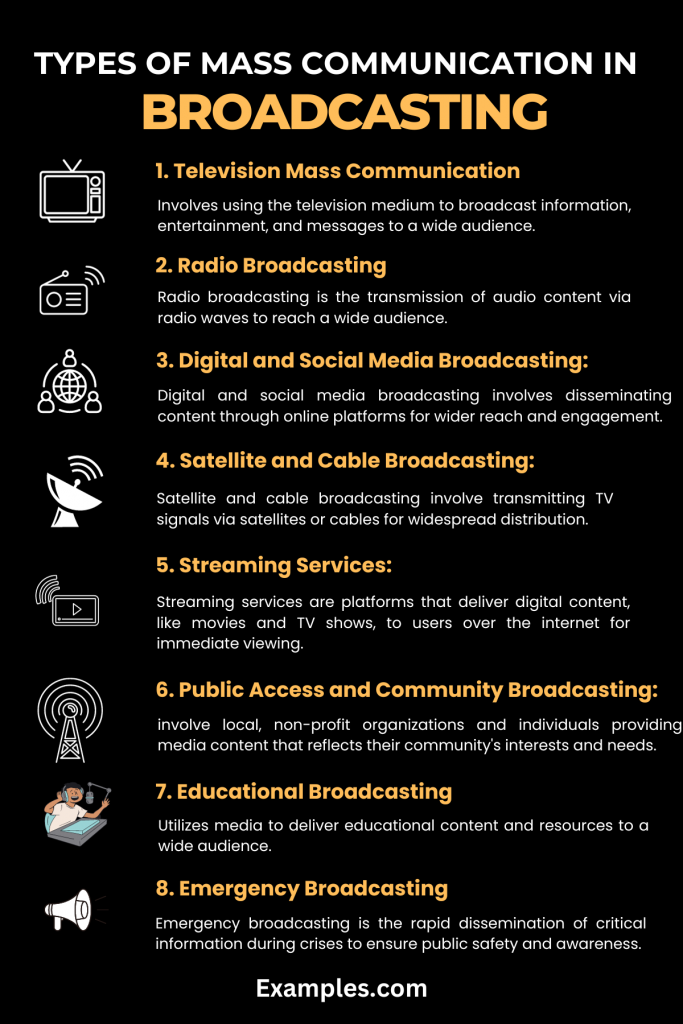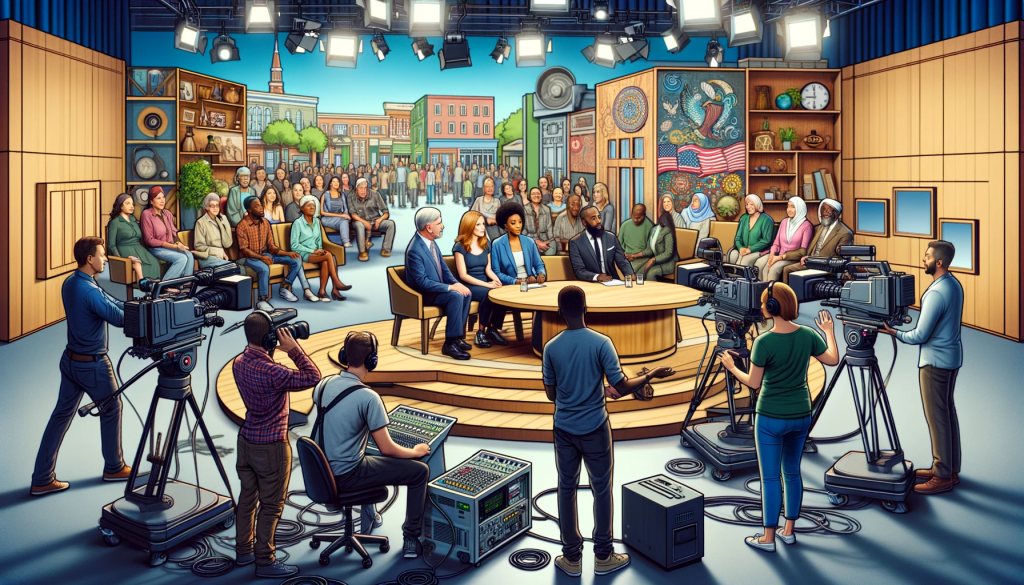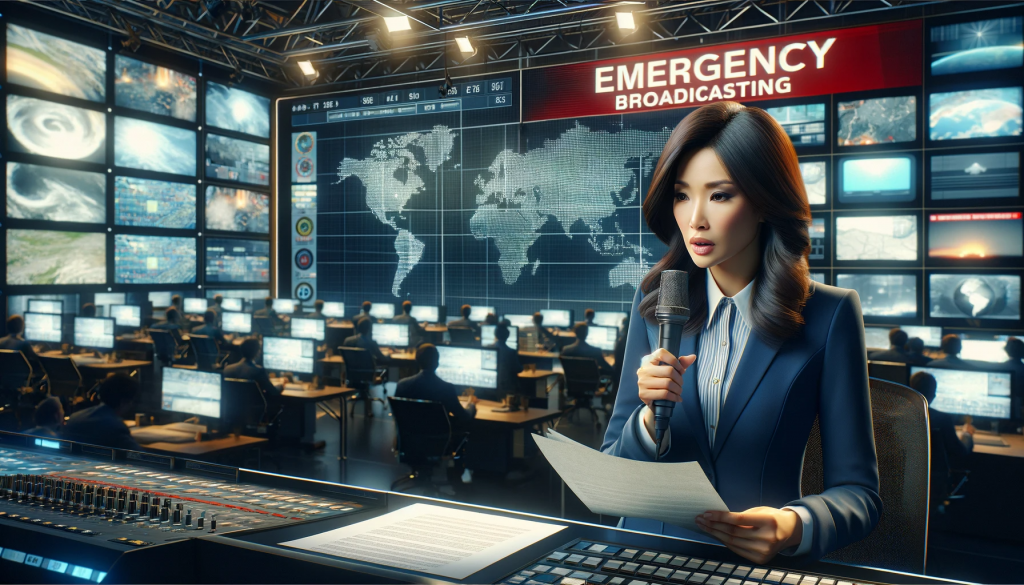29+ Mass Communication in Broadcasting Examples
Delve into the dynamic world of Mass Communication in Broadcasting, a field that seamlessly blends technology and creativity. This comprehensive guide, enriched with practical Communication Examples, offers insights into broadcasting’s role in shaping public discourse. Discover how broadcasting serves as a cornerstone in mass communication, influencing both Social media Mass Communication and traditional media landscapes. Ideal for students, professionals, and enthusiasts, this guide illuminates the path to mastering the art of effective communication in the broadcasting arena.
What is Mass Communication in Broadcasting? – Definition
Mass Communication in Broadcasting refers to the process of transmitting information, ideas, and messages to a large audience through various broadcasting mediums like television, radio, and the internet. This form of communication is designed to reach a wide array of people across different demographics and geographical locations, making it a powerful tool for disseminating news, entertainment, and educational content.
Broadcasting stands out among other Types of Mass Communication due to its ability to provide real-time or recorded content to a mass audience, often simultaneously. This immediacy and wide reach make broadcasting an essential component in shaping public opinion, providing updates during emergencies, and offering diverse perspectives on global events. It plays a critical role in informing and educating people, thereby making it an indispensable part of our daily lives.
30 Mass Communication in Broadcasting Examples
Mass Communication in Broadcasting leverages the reach and influence of television, radio, and digital platforms to disseminate information widely and effectively. It’s integral in shaping public perception, driving social change, and ensuring informed communities. This sector offers diverse Mass Communication Jobs/Careers and plays a crucial role in Public Relations Mass Communication.
- Breaking news broadcasts during emergencies: Swiftly delivers crucial information, ensuring public safety and awareness.
- “Tune in for live updates on the hurricane’s path.”
- “Emergency services are advising residents to evacuate immediately.”
- Educational programs on public television: Enhances learning and brings educational content to a broad audience.
- “Next on our series, learn about the wonders of the solar system!”
- “Join us tonight for a special documentary on climate change.”
- Radio talk shows discussing social issues: Engages the community in dialogue and debate, fostering a better understanding of societal challenges.
- “Call in to share your views on today’s topic.”
- “Up next, we explore solutions to urban housing crises.”
- Televised sports events: Builds community spirit and brings live entertainment to millions.
- “Catch the live action of the World Cup finals on our network.”
- “Experience the thrill of the championship right from your living room.”
- Weather forecasts on local news: Provides essential and timely information to assist in daily planning.
- “Stay tuned for the latest weather updates every hour, on the hour.”
- “Bringing you the most accurate forecast for your weekend plans.”
- Public service announcements on health and safety: Disseminates vital information to large audiences for societal well-being.
- “Learn about the new health guidelines in our special segment.”
- “Remember, safety first! Follow these simple steps to protect yourself.”
- Documentaries on historical events: Educates and informs audiences about significant past events.
- “Discover the untold stories of World War II, tonight at 8.”
- “Join us for a deep dive into the history of the civil rights movement.”
- Cultural programs showcasing arts and music: Promotes cultural diversity and appreciation for the arts.
- “Explore the rich tapestry of world cultures in our new series.”
- “Experience the magic of live orchestra performances, broadcasted just for you.”
- Investigative journalism reports: Uncovers truths and informs the public about critical issues.
- “Our investigative team reveals the story behind the headlines.”
- “Exposing corruption, one report at a time. Stay tuned.”
- Children’s educational content: Offers engaging and informative programming for young audiences.
- “Fun and learning go hand in hand in our children’s show.”
- “Educational and entertaining – cartoons that teach valuable lessons.”
- Live coverage of political events: Brings real-time political developments to the public, fostering democratic participation.
- “Stay with us for live updates from the election headquarters.”
- “Bringing you the latest from the presidential debate.”
- Health and wellness programs: Offers advice on healthy living and wellness tips to a wide audience.
- “Join our daily health show for tips on a balanced diet.”
- “Tune in to learn easy home exercises for busy individuals.”
- Science and technology shows: Demystifies complex scientific concepts and latest tech advancements.
- “Explore the world of AI in our special tech series.”
- “Discover the mysteries of the universe with our science experts.”
- Interviews with influential figures: Provides insights into the lives and thoughts of leaders and celebrities.
- “Tonight, an exclusive interview with the Nobel laureate.”
- “Hear directly from the CEO about the future of technology.”
- Reality TV shows: Offers entertainment while reflecting various aspects of real life and society.
- “Experience the thrill of survival in extreme conditions.”
- “Watch as contestants navigate life’s challenges in our new reality series.”
- Travel and adventure programs: Showcases global cultures and destinations, inspiring viewers to explore.
- “Embark on a journey to the world’s most exotic locations.”
- “Discover hidden travel gems in our weekly adventure show.”
- Cooking and culinary shows: Shares recipes and cooking techniques, appealing to food enthusiasts.
- “Master the art of Italian cooking with our celebrity chef.”
- “Learn quick and healthy recipes for your family.”
- Home improvement and DIY shows: Provides ideas and tips for home decoration and renovations.
- “Transform your space with our DIY home makeover tips.”
- “Get creative with our budget-friendly home improvement solutions.”
- Fashion and lifestyle programs: Keeps viewers up-to-date with the latest trends in fashion and lifestyle.
- “Join us as we explore this season’s fashion must-haves.”
- “Discover lifestyle tips to enhance your daily routine.”
- Game shows and quizzes: Entertains while stimulating the mind and offering educational content.
- “Test your knowledge in our exciting quiz show.”
- “Win big while learning interesting facts on our game show.”
- Music and concert broadcasts: Brings live music events and performances to a broad audience.
- “Experience the concert of the year, right from your home.”
- “Tune in for an exclusive broadcast of the music festival.”
- Animated series for all ages: Offers creative storytelling and entertainment for children and adults alike.
- “Join us for adventures in our award-winning animated series.”
- “Animated tales that capture the imagination of every age group.”
- Wildlife and nature documentaries: Educates about the environment and wildlife conservation.
- “Discover the wonders of the wild in our nature documentary.”
- “Learn about endangered species and conservation efforts.”
- Historical dramas and period pieces: Brings historical events and eras to life through compelling storytelling.
- “Travel back in time with our historical drama series.”
- “Experience the intrigue and drama of the Victorian era.”
- Financial and economic news programs: Provides up-to-date information on markets and economic trends.
- “Stay ahead with our daily financial news roundup.”
- “Gain insights into the global economy with our expert analysis.”
- DIY craft and hobby shows: Encourages creativity and shares tips on various crafts and hobbies.
- “Unleash your creativity with our weekly craft show.”
- “From knitting to woodworking – find your next hobby here.”
- Self-help and motivational programs: Offers guidance and inspiration to help viewers achieve personal goals.
- “Start your day with our motivational talks and tips.”
- “Empower yourself with our series on personal development.”
- Cultural and religious programs: Educates about different cultures and religious practices, promoting understanding and tolerance.
- “Explore world religions and their teachings in our series.”
- “Gain insights into diverse cultures and traditions.”
- Tech and gadget review shows: Provides reviews and information on the latest technology and gadgets.
- “Get the lowdown on the newest tech gadgets in the market.”
- “Your guide to choosing the best electronics for your needs.”
- Youth and teen-focused programs: Addresses topics and interests relevant to younger audiences.
- “Tackling today’s issues from a youth perspective.”
- “Engaging and entertaining content tailored for teens.
What are the Types of Mass Communication in Broadcasting?
Mass communication in broadcasting is a dynamic field that encompasses various types and forms of disseminating information to a large audience through electronic media. Understanding the different types of mass communication in broadcasting is essential for anyone interested in the media industry, whether as a professional or as an informed consumer. In this comprehensive guide, we’ll explore these types in detail, highlighting their unique characteristics and roles in the modern media landscape.

Television Mass Communication
Television mass communication is one of the most influential forms of broadcasting. This medium combines visual and auditory elements to deliver content, making it a powerful tool for entertainment, news, and education. Television broadcasting includes various genres like news bulletins, documentaries, dramas, and live events, reaching diverse audiences across different demographics.

Radio Broadcasting
Radio broadcasting, despite the advent of digital media, remains a vital type of mass communication. It’s particularly effective in reaching remote areas and audiences who prefer auditory content. Radio shows, news, talk shows, and music broadcasting are some of the main formats used in radio mass communication.

Digital and Social Media Broadcasting
With the rise of the internet, digital and social media mass communication have become increasingly prevalent. Platforms like YouTube, podcasts, and social media channels allow for the broadcasting of diverse content, from educational videos to influencer-led programs. These platforms have revolutionized mass communication by enabling user-generated content and interactive engagement with audiences.

Satellite and Cable Broadcasting
Satellite and cable broadcasting have expanded the reach and quality of mass communication. These technologies allow for a wide array of channels and content, catering to niche interests and global audiences. High-definition broadcasts, international channels, and specialized content are hallmarks of this type.

Streaming Services
Streaming services like Netflix and Hulu represent a modern evolution in broadcasting. They offer on-demand content, including movies, series, and documentaries, accessible from various devices. This form of broadcasting caters to the growing demand for personalized and convenient media consumption.

Public Access and Community Broadcasting
Public access and community broadcasting are types of mass communication focused on local content and community involvement. They often provide a platform for local issues, independent artists, and minority voices, contributing to a diverse media landscape.

Educational Broadcasting
Educational broadcasting is dedicated to providing informative content with an educational purpose. This includes children’s programming, documentaries, and instructional series, often in collaboration with educational institutions.

Emergency Broadcasting
Emergency broadcasting systems are crucial in mass communication for disseminating critical information during crises. They provide updates during natural disasters, health emergencies, and other urgent situations, playing a key role in public safety.

What are the differences between broadcast journalism and mass communication?
Broadcast journalism and mass communication are two distinct fields within the media industry. The table below highlights their key differences:
| Aspect | Broadcast Journalism | Mass Communication |
|---|---|---|
| Definition | Focuses on gathering, processing, and disseminating news through broadcast media like television and radio. | Encompasses a broader spectrum of communication methods to reach a large audience, including print, digital, and broadcast media. |
| Scope | Primarily news-oriented, often involving real-time reporting. | Includes various forms of communication such as advertising, public relations, and entertainment, in addition to news. |
| Medium | Restricted mainly to television and radio. | Utilizes multiple platforms including print media, digital platforms, social media, and broadcasting. |
| Audience Interaction | Generally one-way communication, with limited direct audience interaction. | Often encourages two-way communication, especially in digital and social media platforms. |
| Content Creation Focus | Prioritizes timeliness and immediacy of news content. | Focuses on creating content that may be informative, persuasive, or entertaining, not limited to immediate news. |
| Educational Background | Typically requires specialized training in journalism and broadcasting. | May involve a broader educational background in communication studies, encompassing various theories and models. |
| Professional Skills Required | Skills such as live reporting, video editing, and on-camera presentation are crucial. | Requires diverse skills ranging from writing and content creation to strategic communication and media planning. |
How Can I Work In Mass and Broadcast Communications?
Understanding the Industry
Mass and broadcast communications are dynamic fields requiring a blend of creativity, technical skills, and an understanding of the audience. These industries encompass various roles in Broadcasting Mass Communication, Television Mass Communication, and other forms.
Education and Training
- Pursue Relevant Education: A degree in Mass Communication, journalism, or related fields is often essential. Courses in media studies, communication theories, and practical workshops can provide a strong foundation.
- Develop Technical Skills: Gain proficiency in digital technology, editing software, and production equipment. Understanding the technical aspects is crucial for roles in television and radio broadcasting.
Gaining Experience
- Internships and Volunteering: Engage in internships at media houses, radio stations, or TV channels. Volunteering for college radio, local TV stations, or community events can provide practical experience.
- Create a Portfolio: Develop a portfolio showcasing your work, such as articles, videos, or media campaigns. This can be pivotal for roles in Mass Communication Jobs/Careers.
Networking and Continuous Learning
- Networking: Attend industry conferences, join professional groups, and connect with professionals in the field. Networking can open doors to opportunities and provide valuable insights.
- Stay Informed and Adapt: The media landscape is constantly evolving. Stay updated with the latest trends, technologies, and shifts in media consumption patterns.
Career Opportunities
- Diverse Roles: Opportunities range from journalism, production, and editing to roles in public relations, advertising, and digital content creation.
- Specialization: Depending on interest, one can specialize in areas like news reporting, documentary filmmaking, or media management.
In the dynamic field of Mass Communication in Broadcasting, understanding the nuances and strategies for effective communication is crucial. Embracing various forms of Mass Communication, such as broadcasting, is essential for reaching a diverse audience. Remember, the key to success lies not only in the content but also in how it is delivered. Utilize broadcasting as a powerful tool to convey your message, keeping in mind the evolving landscape of Mass Communication. Whether it’s through television, radio, or online platforms, mastering the art of broadcasting ensures your message resonates with the audience, making an impactful contribution to the field of mass communication.



